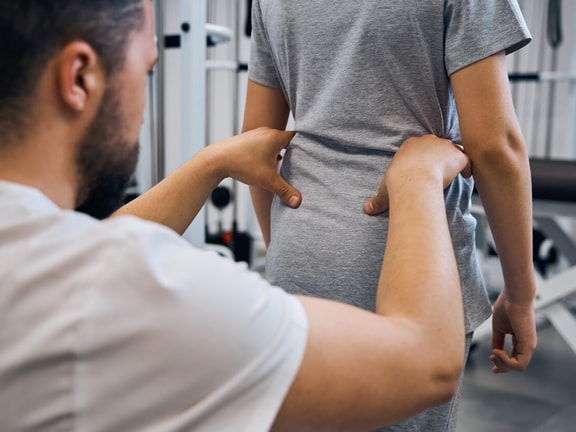Trendelenburg Test: Clinical Use, Interpretation, and Application
August 4, 2025
6 min. read

Assessing Hip Stability in the Clinic
The Trendelenburg test is a common orthopedic examination tool used to assess the function of the hip abductor muscles, particularly the gluteus medius and minimus. For physical therapists, this test provides insight into lower extremity alignment, muscular imbalance, and potential causes of altered gait mechanics.
This article outlines the purpose of the Trendelenburg test, how to perform and interpret it, when to use it, and how to incorporate it into clinical reasoning. It also includes a real-world example to help illustrate its application during patient evaluation.
What Does the Trendelenburg Test Assess?
The Trendelenburg test evaluates the strength and control of the hip abductors, which play a key role in pelvic stabilization during single-leg stance. When these muscles are weak or inhibited, the pelvis drops on the non-weight-bearing side—a pattern commonly referred to as a “positive Trendelenburg sign.”1
Muscles Involved
Primary: Gluteus medius and gluteus minimus
Secondary: Tensor fasciae latae (TFL) and quadratus lumborum (for compensation)
These muscles work to maintain a level pelvis during walking, stair climbing, and standing on one leg. Weakness can contribute to lateral pelvic drop, gait asymmetry, and overuse injuries such as iliotibial band syndrome, patellofemoral pain, or lumbar strain.1
Indications for Use
The Trendelenburg test may be indicated in patients with:
Gait abnormalities (especially Trendelenburg or compensated Trendelenburg gait)
Post-hip surgery (e.g., total hip arthroplasty)
Gluteal tendinopathy or greater trochanteric pain syndrome
Leg length discrepancies
Suspected superior gluteal nerve injury
How to Perform the Trendelenburg Test
Patient Position
The patient should stand upright with feet shoulder-width apart, holding onto a stable surface for balance if needed.
Instructions
Ask the patient to lift one foot off the ground, maintaining a single-leg stance for 30 seconds.
Observe the position of the pelvis.
Repeat on the opposite side.
Positive Test
A positive Trendelenburg sign occurs when the contralateral hip drops (i.e., the side of the lifted leg lowers relative to the stance side), indicating weakness or poor neuromuscular control of the ipsilateral hip abductors.2
Negative Test
The pelvis remains level or slightly elevated on the lifted leg side, indicating sufficient hip abductor strength on the stance leg.
Visual Cues
It can be helpful to observe from behind and use visual references such as the posterior superior iliac spine (PSIS) or waistline for pelvic positioning.
Interpretation and Clinical Implications
A positive Trendelenburg test alone does not confirm a specific diagnosis but should prompt further examination. It may point to:
Weakness in the hip abductors
Hip joint pathology (e.g., arthritis, labral tears)
Poor motor control or balance
Leg length discrepancy
Superior gluteal nerve dysfunction3
It’s also important to differentiate between a true Trendelenburg gait (pelvic drop due to abductor weakness) and a compensated Trendelenburg gait (trunk shift over the stance leg to reduce the abductor load).3
Caution:
False positives may occur in individuals with poor balance or proprioceptive deficits unrelated to hip abductor strength. For accuracy, consider combining the Trendelenburg test with strength testing, gait observation, and functional assessments.
Example: Applying the Trendelenburg Test in Clinical Practice
Patient Case:
A 65-year-old female presents with right-sided lateral hip pain aggravated by walking and lying on her side. She reports difficulty climbing stairs and occasional limping.
Clinical Examination:
Pain on palpation over the right greater trochanter
Positive Trendelenburg sign on the right leg (pelvic drop when standing on right leg)
Weakness (4-/5) in right hip abduction with manual muscle testing
Interpretation:
These findings suggest gluteal tendinopathy and weakness in the right hip abductors, contributing to pelvic instability and increased load on lateral hip structures.
Intervention:
The plan of care includes targeted gluteus medius strengthening, neuromuscular re-education, gait training, and progressive loading exercises to support tendon healing.
This example highlights how the Trendelenburg test, when used in context with other clinical findings, can guide intervention strategies that address both symptoms and root causes.
Hip Flexor Strengthening Exercises PDF
Fill out the form to unlock your free hip flexor strengthening exercises PDF

Limitations and Considerations
While widely used, the Trendelenburg test has limitations. It is a qualitative test and can be influenced by:
Compensatory movement strategies
Patient apprehension or pain
Balance or vestibular impairments
It’s also worth noting that some individuals with significant hip abductor weakness may still demonstrate a “negative” test if they compensate effectively with trunk lean or other muscle groups.
For higher diagnostic accuracy, consider pairing the Trendelenburg test with:
Functional assessments (e.g., single-leg squat)
Instrumented gait analysis or video assessment
Quantitative strength testing using a handheld dynamometer4
The Trendelenburg test remains a valuable tool for physical therapists assessing hip abductor strength and pelvic stability during functional movement. When interpreted in the context of a complete evaluation, it offers meaningful insight into neuromuscular deficits that can inform rehabilitation planning.
Understanding how to perform and interpret this test can support better clinical decision-making, particularly in patients with gait dysfunction, lateral hip pain, or post-operative needs.
The Trendelenburg Test is just one of many tools available to help clinicians diagnose and manage musculoskeletal conditions with greater precision. At Medbridge, we equip providers with the knowledge and resources they need to elevate care—from exam technique to evidence-informed decision-making.
Ready to enhance your orthopedic assessment skills?
Subscribe today to unlock full access to our comprehensive library of orthopedic special tests, including video demonstrations, clinical pearls, and expert-led guidance to support confident diagnosis and effective treatment planning.
To continue building your clinical expertise, visit our PT CEU page for in-depth courses, certifications, and guided learning paths.
References
Grimaldi A, Fearon A. Gluteal tendinopathy: integrating pathomechanics and clinical features in its management. J Orthop Sports Phys Ther. 2015;45(11):910–922. https://www.jospt.org/doi/10.2519/jospt.2015.5829
Hardcastle P, Nade S. The significance of the Trendelenburg test. J Bone Joint Surg Br. 1985;67(5):741–746. https://pubmed.ncbi.nlm.nih.gov/4055874/
Bird ML, Fell J. Positive Trendelenburg test: causes and clinical significance. Physiotherapy Research International. 2014;19(1):37–41. https://pubmed.ncbi.nlm.nih.gov/24038321/
Casartelli NC, Maffiuletti NA, Item-Glatthorn JF, et al. Hip abductor muscle function in patients with hip osteoarthritis: a systematic review. PM&R. 2015;7(5):478–487. https://pubmed.ncbi.nlm.nih.gov/25444030/





